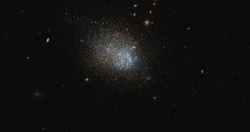Astronomy:NGC 3741
| NGC 3741 | |
|---|---|
 Hubble Space Telescope image of NGC 3741 | |
| Observation data (J2000 epoch) | |
| Constellation | Ursa Major |
| Right ascension | 11h 36m 05s[1] |
| Declination | +45° 17′ 02″[1] |
| Redshift | 0.000764[2] |
| Helio radial velocity | 229 ± 4 km/s[2] |
| Distance | 10 Mly (3.2 Mpc)[3] |
| Apparent magnitude (V) | 14.23[1] |
| Apparent magnitude (B) | 14.55[1] |
| Characteristics | |
| Type | ImIII/BCD[2] |
| Other designations | |
| NGC 3741, UGC 6572, MCG+08-21-068, PGC 35878[1] | |
NGC 3741 is an irregular galaxy in the constellation Ursa Major. It was discovered by John Herschel on March 19, 1828.[4] At a distance of about 10 million light-years (3.2 Mpc), it is located in the M94 Group.[3] It is relatively undisturbed by other galaxies.[3]
NGC 3741 is an unusual galaxy in several aspects. It has a disk of neutral hydrogen (H I) that is extremely wide, extending some 23,000 light-years (7 kpc). The disk is strongly but symmetrically warped.[5] With a mass-to-light ratio of MT/LB ~ 149, it is highly rich in dark matter.[6]
NGC 3741 has a central bar and a faint spiral arm rich in H I. The bar rotates slowly, likely due to interaction with the dark matter.[7] The bar and spiral arms would make NGC 3741 a low-luminosity spiral galaxy.[3] The unusual properties could be explained if NGC 3741 were a late-stage merger between a low-mass companion or if it accreted mass from the intergalactic medium.[3]
References
- ↑ 1.0 1.1 1.2 1.3 1.4 "NGC 3741". SIMBAD. Centre de données astronomiques de Strasbourg. http://simbad.u-strasbg.fr/simbad/sim-basic?Ident=NGC+3741.
- ↑ 2.0 2.1 2.2 "NASA/IPAC Extragalactic Database". http://ned.ipac.caltech.edu/cgi-bin/nph-objsearch?objname=NGC+3741. Retrieved 2018-12-27.
- ↑ 3.0 3.1 3.2 3.3 3.4 Annibali, F.; Bacchini, C.; Iorio, G.; Bellazzini, M.; Pascale, R.; Beccari, G.; Cignoni, M.; Ciotti, L. et al. (2022). "The Smallest Scale of Hierarchy Survey (SSH) – II. Extended star formation and bar-like features in the dwarf galaxy NGC 3741: Recent merger or ongoing gas accretion?". Monthly Notices of the Royal Astronomical Society 512 (2): 1781–1794. doi:10.1093/mnras/stac541. Bibcode: 2022MNRAS.512.1781A.
- ↑ Seligman, Courtney. "New General Catalog Objects: NGC 3700 - 3749". https://cseligman.com/text/atlas/ngc37.htm#3741. Retrieved 23 May 2019.
- ↑ Gentile, G.; Salucci, P.; Klein, U.; Granato, G. L. (2007). "NGC 3741: The dark halo profile from the most extended rotation curve". Monthly Notices of the Royal Astronomical Society 375 (1): 199–212. doi:10.1111/j.1365-2966.2006.11283.x. Bibcode: 2007MNRAS.375..199G.
- ↑ Begum, Ayesha; Chengalur, Jayaram N.; Kennicutt, Robert C.; Karachentsev, Igor D.; Lee, Janice C. (2007). "Life in the last lane: Star formation and chemical evolution in an extremely gas rich dwarf". Monthly Notices of the Royal Astronomical Society 383 (2): 809–816. doi:10.1111/j.1365-2966.2007.12592.x. Bibcode: 2008MNRAS.383..809B.
- ↑ Banerjee, Arunima; Patra, Narendra Nath; Chengalur, Jayaram N.; Begum, Ayesha (2013). "A slow bar in the dwarf irregular galaxy NGC 3741". Monthly Notices of the Royal Astronomical Society 434 (2): 1257–1263. doi:10.1093/mnras/stt1083. Bibcode: 2013MNRAS.434.1257B.
External links
- NGC 3741 on WikiSky: DSS2, SDSS, GALEX, IRAS, Hydrogen α, X-Ray, Astrophoto, Sky Map, Articles and images
 |
